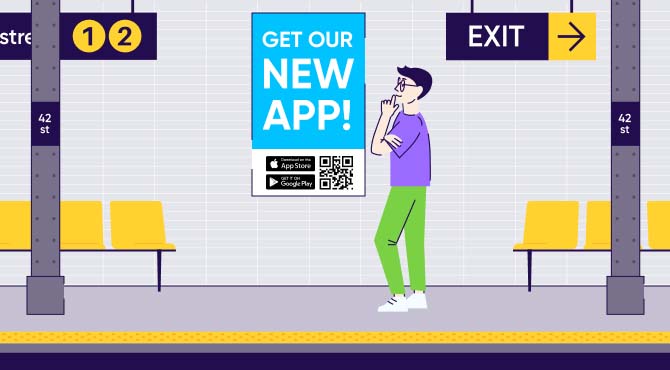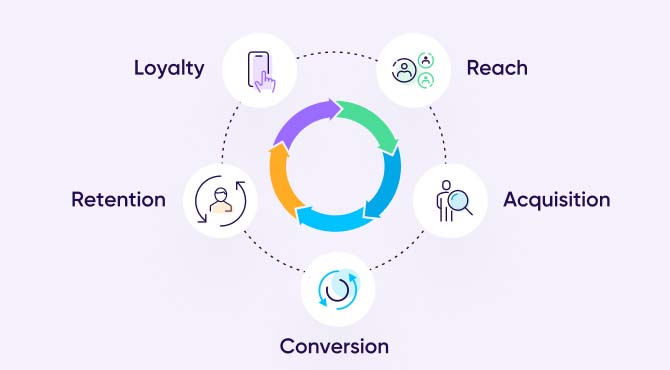
20 additional ways to bring quality users to your app in a privacy-driven, restricted data reality

Ask app marketers how they attract quality users at scale, and they’ll usually respond with a handful of networks: Meta, Google Ads, Apple Search Ads, TikTok, Unity, Liftoff and others as their primary growth drivers, as seen in the AppsFlyer index.
But in an increasingly expensive and privacy-centric reality, marketers are challenged to think more creatively about user acquisition. They shouldn’t overlook alternative ad platforms as channel diversification can be a significant competitive advantage.
Privacy-driven restrictions mean that there are fewer data signals available for optimization, making it harder to find quality users at scale for your app.
In this blog, we’ll look into 20+ new channels so you can strategically diversify your marketing channels in a measured and methodical way.
Start with the why, then figure out the how
Before you dive in headfirst, take a step back and analyze if you’ve cracked the user acquisition code on the main ad platforms. If you haven’t figured out an effective strategy on Meta, Google Ads, Apple Search Ads, and TikTok, it’s unlikely that you’ll find success elsewhere.
Alternative ad platforms should serve as a supplemental way to grow on top of your existing traditional campaigns.
Here are a few additional things to consider before pioneering into new territory.
- Think beyond demographics, and focus on audience affinity. Are users on this platform likely to be interested in your unique selling proposition (USP)?
- What is the user journey? Where will this channel fit within that journey?
- Can it scale? Investing your time and resources into a new platform is not worth starting in the first place if it isn’t.
- How will success be measured? Each channel possesses its unique attribution logic (or none at all). Find out what data you’ll receive from the platform and define your success metrics accordingly.
- What gets users to tick on this platform? What do you know about user behavior and successful ads on this platform? Reusing your top performing Instagram ads are unlikely to succeed on Connected TV. Think deeply into how to craft specific messaging and unique creative – and ensure you have the capabilities to do so.
Now that you’ve gathered as much information as you can about the “audience-channel” fit, let’s explore the 20 alternative platforms and tactics to drive new users to your app.
Platforms with large audiences but limited conversion tracking
Influencer marketing
Influencer marketing is the paid collaboration with influencers to promote and endorse your app with their unique audience. There’s a lot of upside to influencer marketing, especially if their audience is highly relevant and engaged.
Influencer marketing works for almost any budget, depending on the size of influencer you want to work with. App marketers can also boost these posts with paid advertising to market to audiences in a way that’s familiar to the platform.
But it’s a double-edged sword. While the potential to go viral is always an incentive, there’s inherent risk that a collaboration post will underperform. Additionally, managing a campaign with creators is resource intensive and requires a hands-on approach with briefing, communication, and payments. Conversion tracking may also pose a challenge, but marketers can track the performance of a unique link via tools like OneLink.
Podcasts
Podcast placements are audio-only ads that are placed as pre-roll, mid-roll, post-roll, or host-read ads. Since attribution is difficult to measure, podcasts are typically reserved for top of funnel campaigns as most charge on a CPM (cost per thousand listens) basis. Some apps may use coupon codes and unique URLs embedded in the show notes.
Podcast content is vastly popular due to its personal and intimate nature, which opens up opportunities to build strong brand affinity with your audience.
CTV, OTT, and SVOD, AVOD
There are more subscription video on demand (SVOD) accounts than people in the United States. Internationally, there are over 1.88 billion subscribers of over-the-top (OTT) video services.
The increasing demand for streaming services has changed the way we consume content. Leading OTT streaming providers such as Netflix and Disney have made a shift as well, providing ad-based tiers to their subscription offerings.
This has resulted in new ad inventory as well as a transition on the part of advertisers from linear TV to connected TV (CTV); it’s no surprise, then, that OTT video advertising is set to reach revenue of $119 billion by 2023.
As opposed to other streaming ads, CTV ads garner much higher viewing completion. CTV also allows advertisers to measure campaigns as they would their other performance channels. Running campaigns on CTV offers visibility, a new way to engage at key funnel touchpoints, accurate measurement of conversions and ROAS, and the ability to target audiences better than with linear TV.
Ad-based video on demand (AVOD) services like Hulu, Netflix, and Pandora allow you to advertise with premium placements. But these oftentimes require large minimum budgets that only bigger brands can afford.
Traditional radio and out-of-home (OOH)
Don’t discount advertising on more traditional advertising channels like radio and out-of-home billboards. What matters most is that you’re reaching your target audience where they’re at.

Advertisers spent $39.4 billion in OOH in 2022 in the United States and is projected to grow to $45 billion in 2024. With the increasing usage of QR codes and interactive billboards, OOH advertising can be an effective way to amplify your mobile advertising efforts.
Radio advertising isn’t dead either, reaching approximately $12.84 billion in ad spend in 2022. Statista also projects that there will still be 224 million listeners by 2027. The best way to measure the success of radio ads is by measuring what your baseline marketing efforts look like (without the ads), then measure increased search volume, direct traffic, and downloads whenever a spot is run.
Secondary social networks
Reddit, Pinterest, Twitter, Quora
If you’re looking for high-quality and niche users, forums and communities are an excellent source to advertise to. Instead of focusing on volume, these communities present opportunities to build trust and affinity with your core audience.
Oftentimes, these communities are less competitive, but also more difficult to advertise to as you’ll have to carefully navigate the rules of highly moderated communities. Caliber is a fitness app that masterfully ran one of the most successful Reddit app campaigns with its transparent and honest messaging.
You can niche down even more by advertising on VK for the Russian audience, Roblox for teenagers, and even 4Chan like 8fit did in 2015.
Android-specific tactics
Preloaded apps
Preloaded apps are installed on new devices, made available right out of the box. This is a strategy for advertisers who work directly with carriers and manufacturers.
Google Play Auto Install (PAI) can be used to attribute app downloads for preloaded apps on Android devices. Some examples of these premium placements are like NFL Mobile and Audible on Verizon phones.
Third party app stores
There are less-competitive app stores out there that you can optimize for like the Huawei AppGallery, Amazon Appstore, and Samsung Galaxy Store. Although the audience size may be much smaller, it can serve more specific geographies on Android devices.
Digital marketing strategies
Taboola & Outbrain
Taboola and Outbrain are native ad platforms that show up on the bottom of blog posts, news articles, and digital publications. They work with tens of thousands of credible publishers and can help you drive more app installs.
Successful campaigns depend on highly compelling copy and visuals that resonate with the publisher’s audience – context matters! For example, readership on Barstool Sports will vary much differently from someone reading the Wall Street Journal.
You can measure Click-through rate (CTR) and cost-per-click (CPC) and optimize your campaigns based on those two performance metrics.
Search Engine Optimization (SEO)
Search engine optimization (SEO) is the process of optimizing your website to show up higher in relevant search results. When done correctly, you can rank high for app-specific keywords that will ultimately serve as a profitable acquisition channel.
This can be done by publishing relevant content over time, ensuring your website’s performance is stellar, targeting the right keywords, and establishing a strong pool of backlinks to build credibility.
Public Relations (PR)
PR is a tactic of spreading information to the public by generating buzz. It can be as simple as the “Heads Up!” game by Ellen DeGeneres who constantly featured it on her talk show.
Pokemon Go!’s success was also magnified with their PR strategy. They launched several teaser campaigns leading up to its release to generate hype, they partnered with huge brands like Starbucks, ran live events, and worked with popular media outlets upon launch.
Landing pages
A landing page is a web page that advertises your app. Although it’s pretty straightforward, building an effective app landing page requires a fair level of research and design chops. Here are a few things to keep in mind:
- Have clear CTAs that are easy to identify
- Always be A/B testing
- Create trust symbols through well-known logos, customer reviews, and endorsements
- Don’t overload the user experience and keep it as simple as possible. Anything else is a distraction.
Strategic partnerships
Strategic partnerships is often reserved as a B2B strategy. It’s a tactic where you cross-promote your app with another app or business. For example, HBO promoted learning High Valyrian (the language from Game of Thrones) on Duolingo, which was one of the biggest TV shows in 2022. It served as a successful PR campaign for HBO, but also an excellent acquisition strategy for Duolingo with all the press and social media impressions they received as a result of it.
Another example is Lingokids, a children’s educational app, that partnered with airline entertainment systems to be in the in-flight game selection. This helped raise brand awareness and drive installs over time.
Partnerships can be creative, but also straightforward like a coupon deal, links at activations, or simply a co-branded landing page.
The more traditional strategies
App store optimization (ASO)
ASO is the process of improving the visibility, reach, and conversion rates of apps or games in app stores. In an increasingly crowded and competitive app marketplace, ASO is a non-negotiable for every app out there. It’s a continuous process that requires more than just keyword research and includes everything from conversion optimization and LiveOps, promoted IAPs, and more.
Referrals programs
Incentivizing users to refer others is an effective way to get high quality users. For example, food delivery apps have referral programs integrated well into the product experience, making it seamless to refer their friends and family.
An effective referral program begins with the right incentives. This may come in the form of a major financial reward (discount) or a bonus benefit within the app itself like a valuable in-game item.
On the flipside, app marketers must make the reward far enough down the funnel to ensure the process is too difficult to abuse, and take the necessary steps to prevent fraud.
Content marketing
Content marketing is when you create and share valuable content consistently over time to build a loyal and trusting audience. Whether it’s a newsletter list or a large Linkedin following, leverage your existing audience that values your expertise. You may even consider working with other influencers or offer exclusive promotions with your audience to incentivize them to download your app.
Lifecycle marketing
Lifecycle marketing is creating a touchpoint in every step of the marketing cycle by utilizing push notifications, email, SMS, and remarketing to nurture prospects and upsell existing users. Ensuring you have every stage of the funnel covered also helps minimize churn and reactivate dormant users.

Mergers and acquisitions
The gaming industry has experienced a tectonic shift over the past year. Whether it’s Microsoft’s potential record-breaking acquisition of Activision Blizzard for $68.7 billion or Take-Two’s Zynga acquisition, brands are recognizing the value of acquiring first-party users with high brand affinity. Especially in an increasingly privacy-centric environment, acquiring another app is an effective way to grow the bottom line and cross-promote your games across a larger pool of users.
Where will you explore?
Diversified acquisition channels can help determine the long-term success of your mobile app campaigns. With so many channels that we’ve explored above, which one will you go with?
As eager as you probably are to dive right in now, don’t forget to define your target audience, identify your goals, research each acquisition channel, and test and measure everything.





